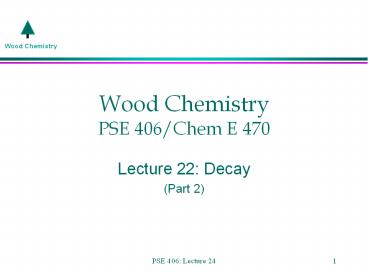Wood Chemistry PSE 406/Chem E 470 PowerPoint PPT Presentation
1 / 17
Title: Wood Chemistry PSE 406/Chem E 470
1
Wood ChemistryPSE 406/Chem E 470
- Lecture 22 Decay
- (Part 2)
2
Enzyme Function
- There are a large number of fungal enzymes
responsible for the breakdown of each wood
component. Each enzyme plays specific roles
(cellulase example from reading) - Cellobiohydrolase (CBH), acts on the end of the
molecule successively cleaving off the
disaccharide cellobiose. - Endo-beta-1,4-glucanase acts within the chain,
breaking it into smaller units and providing more
"ends" for CBH. - Beta-glucosidase (or cellobiase) which cleaves
cellobiose to two glucose units. - These enzymes working together produce glucose
which is consumed by the fungi.
http//helios.bto.ed.ac.uk/bto/microbes/armill.h
tm
3
How do Enzymes Function?
- Enzymes react with cellular components through
free radical processes. - Free radicals (as earlier discussed and covered
in notes section) are very reactive species. - Enzymes in the form of free radicals will oxidize
wood components directly (abstracting an electron
thus turning the wood chemical into a reactive
free radical). - Lignin peroxidases are able to oxidize a wide
variety of compounds through this process. - Other enzymes are not able to do this.
Notes
4
Other Oxidizing Techniques
- Because the enzymes are so large, it is most
often necessary to use small reactive free
radicals (or other reactive species) to do the
dirty work. - A good example of this are the manganese
peroxidases. In this system, the enzyme oxidizes
Mn2 to the powerful oxidant Mn3 which can
penetrate the cell wall to react with cell wall
components. - Many of the small radicals are produced through
reaction of the enzymes with cellular components
(like lignin).
5
Free Radical Candidates
- Compounds present in the plant material
- Metals (Mn, Fe, Cu)
- Oxygen (see next slide)
- Compounds produced by enzyme
- H2O2, veratryl alcohol, oxalates
- Degradation products from wood
- Phenolic compounds (example RO?)
- Other aromatic compounds (example RCO2? )
- Quinones
6
Reactive Oxygen Species
- HO2 hydroperoxy radical, pKa 4.8
- Ionized form (- O2) Superoxide radical weak
oxidant. - H2O2 hydrogen peroxide, pKa 11.6
- ionized form (-HO2) hydroperoxy anion weak
oxidant - HO. Hydroxide radical (strong oxidizer), pKa
11.9 - Ionized form (-O) oxyl anion radical
- Many of these species are formed through the
interaction with metals Fentons chemistry
7
Summary (to date)
- So here is what we have learned to date
- Decay by fungi is caused through enzymatic free
radical reactions. - The reactions can either be the enzymes
themselves or smaller free radical species
produced through reaction with the enzymes. - These free radicals react with the cellular
components breaking them into fragments many of
which are useable by the fungi.
8
What Happens to the Chemicals Unloved by the
Fungi?
- Basically the question is what happens to all of
the organic material that is not consumed by the
organisms? - In this picture, the log is rotting leaving a
pile of organic material on top of the soil. - Does this organic material simply disappear?
9
Soil Organics
- The answer to the question on the last slide is
of course not, the organic material doesnt
disappear it is simple changed into the soil
organics Fulvic Acids, Humic acids, and Humins.
These materials are classified by their
solubility. - Fulvic Acids (Acid soluble fraction)
- Humic acids (Alkali soluble fraction/ acid
insoluble) - Humin (Insoluble organics)
10
Soil Organics II
- These materials are very important to the soil
(As lignin is to everything else) - The amounts of these compounds is very soil type
dependent. - 60-70 of soils organics are humin, humic acids
and fulvic acids - Soil organic matter ranges from 0.5 to 20 of
the soil material
11
Structure of Soil Organics
- These soils organics are large polymers and thus
like lignin structural determination is somewhat
difficult. - Fulvic acid Mw2000, humic acids higher, humins
as high as 300,000? - These materials are more difficult than lignin
for structural studies because they are produced
from so many different materials (unlike lignin
3 possible precursors)
12
Proposed Humic Acid Structure
- This is a proposed segment of humic acid by
Stevenson - Notice the phenolics, the sugars, and the
peptides - It is obvious that this molecule does not arise
directly from any component but is built from
pieces of other components.
13
Proposed Fulvic Acid Structure
- This is a proposed structure for a fulvic acid
fragment by Buffle
14
Formation of Soil Organics
- There is a tremendous amount not known about this
process. - This figure (borrowed from a website) shows 4
proposed routes to humic substances
15
Formation of Humus Directly from Lignin
- This is an old theory (1932) that was accepted
for a very long time but is now in disfavor. - In this route, lignin is modified by enzymatic
reactions forming humic substances.
Once again this is a borrowed image
16
Formation of Humus from Degradation Products
- In these 2 pathways, lignin and carbohydrates are
broken into fragments which are modified and then
linked together to form the polymers. - These routes are more highly accepted.
17
Formation of Humus from Sugar-Amine Condensation
- In this final route, the organic material is
formed through reactions between sugar
degradation chemicals and organic nitrogen
materials.

